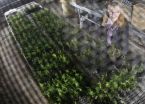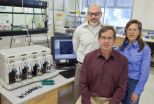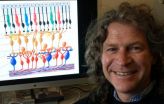(Press-News.org) GAINESVILLE, Fla. — A new University of Florida study shows cats are the dominant predator to mockingbird eggs and nestlings in urban areas, prompting conservationists to urge pet owners to keep felines indoors at night.
The findings challenge assumptions that urban areas are places of refuge for nesting mockingbirds, a species researchers say plays an important role in controlling insect pests and serving as environmental indicators for metropolitan areas.
"I thought the cats probably really hammered them [birds] when they were fledglings, but when they were in the nests, I didn't really expect the cats to be a huge problem," said study author Christine Stracey, who led the research as a doctoral student at the Florida Museum of Natural History on the UF campus. "But I was really wrong about that."
Researchers video recorded northern mockingbird nest predators in urban and natural habitats during the nesting seasons from 2007 to 2009. The study in the May 2011 issue of Biological Conservation shows cats were responsible for more than 70 percent of the urban attacks.
The highest population densities of the mockingbird – the state bird of five states including Florida — are found in urban areas. Urbanization is one of the main causes of species endangerment in the United States, but some species such as the mockingbird have adapted extremely well to humans and urban environments, said Florida Museum of Natural History Ordway Eminent Scholar Scott Robinson, Stracey's research adviser.
"Here's this native species that is able to not only live with us, but do really well living with us, and so it represents kind of the opposite of what we normally think about the effects cities have on native birds," said Stracey, now an assistant professor of biology at Westminster College in Salt Lake City. "If we can figure out why and how it succeeds, maybe there's ways and things we can do in terms of city planning and management that could promote the success of some of these other native species that aren't doing as well."
Researchers used small security cameras from March to August each year in Gainesville, including the Duck Pond and Capri neighborhoods, at the Ordway-Swisher Biological Station in Putnam County and in UF-owned pastures. The 57 documented incidents showed Cooper's hawks carried out a majority of nest predation events in rural areas. After cats, snakes were the second-most dominant predator in urban areas, followed by the American crow and swallow-tailed kite. These three were also observed as predators in non-urban areas, in addition to the flying squirrel, opossum, raccoon and blue jay.
"We only put cameras on mockingbird nests, but there are a number of species that nest in similar places," Stracey said. "We don't see any reason why cats wouldn't also eat cardinal nestlings, brown thrashers, towhees – anything else that is nesting in similar locations."
Because infrared cameras captured night events, the black-and-white footage made it difficult to distinguish if all cats were pets, but Stracey said some were wearing collars.
"All but one of these cat events occurred at night," she said. "People should not let their cats roam outdoors at all, but at the very least, keeping them inside at night will cut down on nest predation. Beyond that, we need to think hard about the feral cat problem."
In the last 20 years, the "Sylvester & Tweety" issue has become increasingly controversial, with birders and cat lovers taking the stand. The American Bird Conservancy reports cats kill hundreds of thousands of birds in the U.S. every year. An invasive species, cats are prized as pets for their ability to control pests, such as rodents. Previous research has focused on rates of cat predation on adult birds, and this data adds new factors when investigating declines in bird populations.
"There are a lot of loud voices that deny cats are important predators of birds in our cities," said Amanda Rodewald, a professor of wildlife ecology at Ohio State University. "But this study shows clearly that cats were the dominant predator in this Florida system – and that wasn't presumed, it was recorded on video, so it was fact."
The study also challenges assumptions about how urban systems operate, as the different foods available in cities result in altered foraging behaviors, Rodewald said. To the researchers' surprise, five of the 17 cat attacks in urban areas were aimed at the eggs.
Robinson describes urbanization as a critical issue.
"We think of urbanization as a disaster for birds," Robinson said. "We strongly believe that it's important to keep wildlife in urban settings so people don't lose their connection with wildlife."
###
Videos of the nest predation events recorded for the study may be viewed online at www.flmnh.ufl.edu/ordwaylab/stracey/video.html.
Credits
Writer
Danielle Torrent, dtorrent@flmnh.ufl.edu
Media Contact
Paul Ramey, pramey@flmnh.ufl.edu, 352-273-2054
Source
Christine Stracey, cstracey@westminstercollege.edu, 801-832-2364
Source
Scott Robinson, srobinson@flmnh.ufl.edu, 352-273-1965
UF study finds cats No. 1 predator to urban mockingbird nests
2011-05-08
ELSE PRESS RELEASES FROM THIS DATE:
Practice can make search-and-rescue robot operators more accurate
2011-05-08
Urban search and rescue (USAR) task forces are essential for locating, stabilizing, and extricating people who become trapped in confined spaces following a catastrophic event. Sometimes the search area is too unstable for a live rescue team, so rescuers have turned to robots wielding video cameras. Most recently, the USAR robots have been employed by rescuers following the devastating Japanese earthquake and tsunami. The rescuers control, or teleoperate, from a safe location. Teleoperation can be problematic, as robots frequently become stuck, which can destabilize the ...
Robot based on Carnegie Mellon research engages novice computer scientists
2011-05-08
PITTSBURGH—Learning how to program a computer to display the words "Hello World" once may have excited students, but that hoary chestnut of a lesson doesn't cut it in a world of videogames, smartphones and Twitter. One option to take its place and engage a new generation of students in computer programming is a Carnegie Mellon University-developed robot called Finch.
A product of CMU's famed Robotics Institute, Finch was designed specifically to make introductory computer science classes an engaging experience once again.
A white plastic, two-wheeled robot with bird-like ...
Short antibiotic courses safer for breathing-tube infections in children
2011-05-08
Short courses of antibiotics appear just as effective as longer ones
- and a great deal safer - in treating respiratory infections that might cause pneumonia in children on temporary breathing devices, according to a Johns Hopkins Children's Center study published online May 3 in Clinical Infectious Diseases.
In the study's analysis of 150 children treated with antibiotics for respiratory infections while on a ventilator, longer antibiotic courses did not only fail to confer extra protection against full-blown pneumonia when compared with shorter therapy, but also considerably ...
Selaginella genome adds piece to plant evolutionary puzzle
2011-05-08
WEST LAFAYETTE, Ind. - A Purdue University-led sequencing of the Selaginella moellendorffii (spikemoss) genome - the first for a non-seed vascular plant - is expected to give scientists a better understanding of how plants of all kinds evolved over the past 500 million years and could open new doors for the identification of new pharmaceuticals.
Jody Banks, a professor of botany and plant pathology, led a team of about 100 scientists from 11 countries to sequence the genome of Selaginella, a lycophyte. Lycophytes, which are the oldest living vascular plants, shed spores ...
Wistar researchers: Direct proof of how T cells stay in 'standby' mode
2011-05-08
For much of the time our T cells—the white blood cells that act as the police of the immune system—are in what immunologists call a "quiescent state," a sort of standby mode. For years, scientists have wondered if quiescence occurred by default or whether T cells need to work at remaining silent. Now, researchers at The Wistar Institute provide the first direct proof that a protein, called Foxp1, actively maintains this state of quiescence in T cells until the cells are called upon by other parts of the immune system.
Their findings, which appear online through Nature ...
It takes a community of soil microbes to protect plants from disease
2011-05-08
Those vegetables you had for dinner may have once been protected by an immune system akin to the one that helps you fight disease. Scientists from the U.S. Department of Energy's Lawrence Berkeley National Laboratory (Berkeley Lab) and the Netherland's Wageningen University found that plants rely on a complex community of soil microbes to defend themselves against pathogens, much the way mammals harbor a raft of microbes to avoid infections.
The scientists deciphered, for the first time, the group of microbes that enables a patch of soil to suppress a plant-killing pathogen. ...
Antibodies help protect monkeys from HIV-like virus, NIH scientists show
2011-05-08
WHAT:
Using a monkey model of AIDS, scientists have identified a vaccine-generated immune-system response that correlates with protection against infection by the monkey version of HIV, called simian immunodeficiency virus (SIV). The researchers found that neutralizing antibodies generated by immunization were associated with protection against SIV infection. This finding marks an important step toward understanding how an effective HIV vaccine could work, according to scientists who led the study at the National Institute of Allergy and Infectious Diseases (NIAID), part ...
Anatomy of an outbreak
2011-05-08
GALVESTON, Texas — What causes a virus to suddenly begin infecting large numbers of people?
Scientists have long known that the process they call "viral emergence" involves a wide variety of factors. Some are changes in the environment, either generated by natural causes or human activity. Others are internal, arising from accidental changes — mutations —in the virus' genetic code.
Studying such mutations in different strains of the chikungunya virus has helped University of Texas Medical Branch researchers solve one of the most puzzling mysteries of chikungunya's ...
Forecast calls for nanoflowers to help return eyesight
2011-05-08
EUGENE, Ore. -- University of Oregon researcher Richard Taylor is on a quest to grow flowers that will help people who've lost their sight, such as those suffering from macular degeneration, to see again.
These flowers are not roses, tulips or columbines. They will be nanoflowers seeded from nano-sized particles of metals that grow, or self assemble, in a natural process -- diffusion limited aggregation. They will be fractals that mimic and communicate efficiently with neurons.
Fractals are "a trademark building block of nature," Taylor says. Fractals are objects with ...
DNA from common stomach bacteria minimizes effects of colitis, U-M study says
2011-05-08
ANN ARBOR, Mich. — DNA from Helicobacter pylori, a common stomach bacteria, minimizes the effects of colitis in mice, according to a new study by University of Michigan Medical School scientists.
The study published in Gut this month was performed by a team of investigators assembled by senior author John Y. Kao, M.D. of the University of Michigan's Division of Gastroenterology and assistant professor in U-M's Department of Internal Medicine. The findings indicate that DNA from H. pylori significantly ameliorates the severity of colitis, say lead authors Jay Luther, M.D. ...


